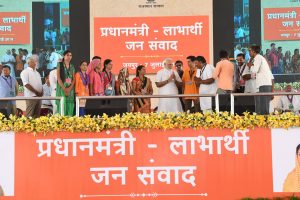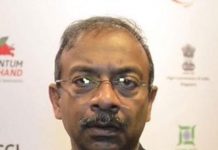 Prime Minister Narendra Modi’s speech at the much touted ‘mammoth’ rally at Jaipur on July 7 perhaps has sounded as the signal ahead of the state assembly elections. These elections are scheduled to be held in Chhattisgarh, Madhya Pradesh, Mizoram and Rajasthan by this year end and Lok Sabha elections in mid-2019. Four major issues — Demonetisation, Goods and Services Tax (GST), Employment and Foreign Policy — which the ruling BJP claims as its USP and the Opposition parties as the prime ammunition to target the ruling dispensation during the ensuing electoral campaigns. Undoubtedly, local and regional issues like law and order, the plight of the farmers along with other issues will rule the roost of campaigning particularly in Chhattisgarh, Madhya Pradesh and Rajasthan assembly hustings; nevertheless, the four national issues will play a pivotal role as well. These issues have formed the highlights of Prime Minister Modi’s recent interview to Swarajya magazine also.
Prime Minister Narendra Modi’s speech at the much touted ‘mammoth’ rally at Jaipur on July 7 perhaps has sounded as the signal ahead of the state assembly elections. These elections are scheduled to be held in Chhattisgarh, Madhya Pradesh, Mizoram and Rajasthan by this year end and Lok Sabha elections in mid-2019. Four major issues — Demonetisation, Goods and Services Tax (GST), Employment and Foreign Policy — which the ruling BJP claims as its USP and the Opposition parties as the prime ammunition to target the ruling dispensation during the ensuing electoral campaigns. Undoubtedly, local and regional issues like law and order, the plight of the farmers along with other issues will rule the roost of campaigning particularly in Chhattisgarh, Madhya Pradesh and Rajasthan assembly hustings; nevertheless, the four national issues will play a pivotal role as well. These issues have formed the highlights of Prime Minister Modi’s recent interview to Swarajya magazine also.
Demonetisation
Demonetisation was launched on November 8, 2016, as a means of tackling the black economy, stop the circulation of fake currency and stop funding of the terrorists in J&K and the Maoists-hit areas. Undoubtedly, the Modi Government claims its measure of launching the demonetisation having achieved its avowed objectives; nonetheless, a vast majority of experts and major Opposition parties rebut official claims. It is argued that demonetisation was carried out on the incorrect premise that black money means cash. It was also thought that if cash was squeezed out, the black economy would be eliminated. However, some experts opine that cash is only one component of black wealth: about 1% of it. It has now been confirmed that 98.8 per cent of demonetized currency has come back to the Reserve Bank of India.
Arguing that not even 0.01 per cent of the black money has been extinguished, some critics point out that the big failure of demonetisation is that it was carried out without preparation and caused big losses to the unorganised sector. This has not been factored into the recent data on growth rate, so the loss to the economy could be in lakhs of crores of rupees. Farmers, traders and the youth are all agitating. Recent media reports also show a two-fold increase in the deposits by Indians in Swiss banks during 2017 and some critics call it a ‘failure of demonetisation.’ Even the government’s claim about demonetization as a way of addressing a large number of fake currency notes circulating in the economy was based on a false premise, as it turned out, it was closer to 40 crore.
Linkage to terrorism, as one of the main components of the reason for demonetisation, and its outcome in terms of the way it was articulated has been abysmal. In the wake of the failure of attaining the declared objectives of demonetisation, some experts point out that the goalposts started shifting when it became apparent that the main reason was not justified by what was happening. Apart from a vast majority of experts raising scepticism over the demonetization, the Opposition is also questioning the rationale behind such a ‘drastic’ measure to which the ruling dispensation has no satisfactory answer.
Goods and Services Tax
The GST, launched with much fanfare last year, has just completed one year. The Modi government wants the nation to believe the new tax has been a great success — not surprising, given this government’s marketing orientation. In the wake of media reports that the GST collections in each of the months between March 2018 and May 2018 have been lower than the collection in February 2018. In 2018-2019, the Central government hopes to earn 6, 03, 900 crore from central GST. Some economists opine that this works out to 50,325 crore per month on an average. The collections in April and May 2018 were 32,089 crore and 28,119 crore, respectively. Pointing out that this being way below the target of 50,325 crore per month, some economists ask as to how does this make GST a success, when the government is not able to achieve the target it set for itself.
While drawing attention to the decline in Indian merchandise exports as a proportion of the GDP owing to the GST, some critics opine that prior to the implementation of the GST, the exports to GDP ratio was 12.1 per cent in 2016-2017 and in 2017-2018, it fell to 11.7 per cent in post GST period. According to these critics, a major reason for this is because exporters did not get GST refunds on time, which created a working capital problem for them. The multiplicity of GST rates: 5, 12, 18 and 28 per cent is the fundamental problem of the GST system. The prime minister Modi’s recent defence of the GST by saying that milk and Mercedes cannot be taxed at the same rate is rebutted by some experts who argue that milk is not taxed under GST and pitiably while diamonds are taxed at 0.25 per cent and gold at 3 per cent, sanitary napkins are taxed at 12 per cent.
Employment
The Opposition has been questioning the Modi-led government on providing two-crore jobs every year as promised during the elections and there is no satisfactory answer in the absence of reliable statistics. As the formal sector accounts for just about 8-15 per cent of India’s workforce, the official estimates are completely silent about the majority of the workforce engaged in the informal sector. While raising the question as to why few jobs are so created when the economy is said tobegrowing at over 7 per centsome critics opine that an answer is that GDP growth figures are probably overestimated on account of the mis-measurement of GDP in the new National Accounts Statistics and this leads one to believe that the economy is probably growing much slower.
While raising doubts about government’s claim that 4.1 million new jobs were created in the economy’s formal sector during since September 2017, some experts argue that this data is based on the enrolment of additional workers under state-provided (or mandated) social security schemes; therefore, this claim seems questionable on empirical and conceptual considerations. Besides, the official claim is about the formal or organized sector, which at best counts for 15 per cent of India’s labour force and there is no way of knowing what is happening in agriculture and the non-farm informal sector, accounting for 85per cent of the workforce.
Foreign Policy
Much-hyped foreign visits to over 50 countries during the past years by prime minister Modi are touted as ushering in the dawn of a new era in India’s relations with other countries. However, experts disagree with this hype by pointing out that India has lost its eminent position in South Asia owing to its ‘reckless adventurism’ in its neighbourhood, which is tilting towards China. A pall of ‘unease’ has reportedly descended on India’s relations with China in the wake of Doklam standoff and Modi has to visit China thrice thereafter to keep the later in good humour. Russia holding anti-terror drills with Pakistan in 2017 attest to ‘decline’ in the special relationship with Moscow.
Many experts opine that India has come to face a unique combination of diplomatic, security and strategic challenges under the Modi government. The growing economic, defence and strategic partnership with the U.S. is being questioned on account of the transactional nature of the Trump administration, its unreasonable trade demands, and its sanctions related to Iran and Russia that are unmindful of India’s interests and costs. Some of India’s efforts, such as membership of the Nuclear Suppliers Group and a facility in Seychelles, have been stymied and not to talk of India’s membership of the UN Security Council.
Way Forward
Aggressive propagation of cultural nationalism resulting in mob-lynching, unabated atrocities on Dalits and minorities, increasing incidents of crimes against women, burgeoning unemployment and the miserable plight of the farmers, especially in the BJP-ruled states, along with failure in fulfilling its promises have cumulatively made the picture more complicated. There are strong sui generis challenges and headwinds, requiring course modulation and adaptation. Fudging the data to conceal its failures and projecting a greener pasture to hoodwink the gullible masses via publicity blitzkrieg may look attractive for the BJP to wrest power again; nevertheless, it also affords sufficient ammunition for the Opposition to target the BJP, provided it gets its house in order and present a united face. The ensuing assembly elections in four states by year-end is going to be a testing ground and one needs just to wait and watch.
letters@tehelka.com













